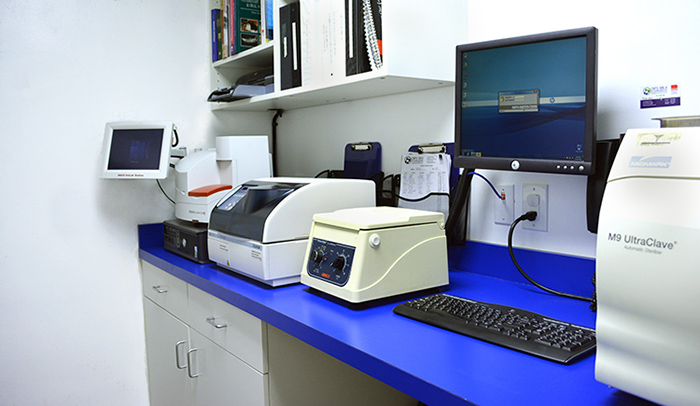Laboratory
Our hospital is equipped with an in-house laboratory to provide same day results with common blood and urine tests. This is particularly useful when your cat is suddenly unwell and needs appropriate treatment quickly. We also use an outside laboratory for wellness screens and additional specialized tests. Below are explanations of commonly used blood and urine tests.

Our feline friends cannot (or do not) tell us when they are unwell. We often use blood and urine tests along with a detailed history and comprehensive physical examination to help us determine if there is a problem internally. In some respects, the blood and urine tests are helping our patients “speak to us”. In our experience, our patients typically “look sick” during advanced stages of disease and appear “sick” suddenly despite the fact that disease has been present for weeks to months. Remember, cats are small and had many predators in the wild. If they exhibited signs of illness or weakness, they would fall victim to predators. What does this mean? This inherent instinct of cats translates into cats showing they are unwell only during advanced stages of disease when they cannot “hide” disease anymore. By hiding the fact that they are unwell, they avoid detection by predators.
To help counteract this inherent nature of the cat, we recommend annual blood and urine tests. This concept is called Patient Trending which allows our doctors to do a number of things. Firstly, we are able to establish normal values for your individual cat while they are young and healthy. Secondly, by comparing the results year after year, we are able to detect changes early. Not only are we able to detect changes when values fall outside the normal reference range, we are able to spot and monitor changes within the reference range. For example, if your cat’s kidney values begin to increase but are still within the reference range, we have an opportunity to begin treatment early and monitor the trends more closely. Patient Trending can be a powerful tool to detect and treat disease early. Again, the main goal is to ensure our patients lead healthier, longer lives.
Young Wellness Screens
In an attempt to pursue Patient Trending and establish your individual cat’s normal values, we pursue an annual young wellness screen in our patients less than 8 years of age. What is included in this screening? (1) mini chemistry Panel, (2) complete blood count and (3) a urinalysis.
Senior Screens
Age is not a disease; however, we know the diseases that affect our patients in their later years. At 8 years of age, we pursue a more comprehensive screening in an attempt to continue the Patient Trending started early in life and to aid our doctors in detecting and treating disease early. The most common diseases in our older patients include kidney disease, thyroid disease, diabetes mellitus, and inflammatory bowel disease (IBD, IBS). The goal is prevention and early detection. What is included in this screening? (1) chemistry panel, (2) complete blood count, (3) thyroid hormone (T4) and (4) urinalysis.
Diagnostic Tests
Fecal Analysis
Approximately 20% of fecal tests run at Cats Only Veterinary Hospital are positive for parasites and the vast majority of our patients are indoor only. We recommend a fecal analysis at least every 12 months for our patients. A number of these parasites are zoonotic or can be transferred to humans. Young children, the elderly, or immunocompromised individuals are at greatest risk from a zoonotic parasite. Parasites that we screen for include roundworms, hookworms, tapeworms, Toxoplasma, giardia, coccida, and Cryptosporidium. Please visit the links below for more information.


Feline leukemia (FeLV) & feline immunodeficiency virus (FIV)
Feline leukemia virus (FeLV) and feline immunodeficiency virus (FIV) are major causes of illness and death in cats. Our hospital strictly follows the American Associations of Feline Practitioners (AAFP) Retroviral Testing Guidelines. All kittens (and cats) should be tested at least twice in their lifetime 2-3 months apart. All unwell patients need to be tested, even if done previously, as the viruses may “hide” within the body and “come out” at a later date.
Chemistry Panel
These routine blood tests evaluate a number of internal organs and secondary changes when disease is present. Our chemistry panels provide our doctors with the following important information:
Kidneys Two waste products in the blood, creatinine and BUN (urea), give us a sense if your cat’s kidneys are functioning correctly. A new kidney marker, SDMA, appears to be more sensitive than creatinine and can pick up kidney disease much earlier. All of our chemistry panels run at Cats Only have this SDMA test included in the panel.
Liver Changes in your cat’s liver enzymes (ALKP, ALT) and bilirubin levels helps us determine how this important organ is functioning.
Electrolytes & Minerals Many diseases may change or alter your cat’s electrolytes (sodium, chloride, potassium) and minerals (calcium, phosphorus, magnesium). Patterns of electrolyte disturbances or changes in mineral content in the blood may give important clues to the health of your cat.
Blood Proteins Changes in blood proteins (albumin, globulin, total protein) may indicate an inflammatory process, and infectious process, or disease in an internal organ.
Glucose Measurement of your cat’s blood sugar helps screen for diabetes.
Complete Blood Count (CBC)
These routine blood panel evaluates bone marrow cell production and the immune system. Our complete blood counts provide our doctors with the following important information:
White Blood Cells White blood cells help your cat’s body fight off infection. Changes in specific white blood cells lines (neutrophils, lymphocytes, eosinophils, monocytes, basophils) may give important clues to the health of your cat. Abnormalities may indicate an infection, inflammation or cancer.
Red Blood Cells Changes in red blood cell parameters may give us a clue about a bone marrow disorder, parasites, chronic disease in an internal organ, or an immune-mediated process.
Platelets Platelets are used to form clots and prevent bleeding from blood vessels. Changes in platelet counts may indicate a problem about your cat’s health.
Thyroid Hormone (T4)
The most common hormone disorder in cats results from an abnormal enlargement in the thyroid gland and an excessive production of thyroid hormone. Clinically, you may notice weight loss, a ravenous appetite, vomiting, and behavior change. All cats over 8 years of age should be screened for thyroid disease annually.
Urinalysis
Evaluation of the urine is an important aspect of our above wellness profiles. Our urinalysis evaluates for the following: (1) Urine concentration (this helps evaluate kidney function), (2) Presence of crystals, (3) Presence of bacteria, (4) Cells (red blood cells, white blood cells, kidney cells, other abnormal cells), (5) Glucose, (6) Protein, (7) Ketones, (8) Bilirubin.
Blood Glucose (BG) Curves
We perform BG curves on our diabetic patients to monitor the response to insulin injections administered at home. These curves are pursued in new diabetic patients and diabetic patients that suddenly become uncontrolled. A BG curve determines the blood glucose level every 2-4 hours (depending on the insulin used) throughout the day. We are able to monitor the blood glucose “highs” and “lows” in response to the insulin administered. With this information, we are able to make sure your cat is receiving an appropriate dose of insulin.
Heartworm Antibody & Antigen Tests
These tests help us evaluate our patients for previous and current heartworm infections. This blood tests evaluates for antibodies against heartworms in your cat. A positive heartworm test means your cat had a previous heartworm infection. A positive heartworm test may also mean an increased risk for anesthesia. Feline heartworm disease is a serious, life-threatening disease and is 100% preventable with year round protection. There is currently no treatment for heartworm disease in cats, so screening and prevention is key!
Fructosamine
For our diabetic patients, this tests helps us monitor our insulin treatment by taking an average of the blood glucose in the previous 2-3 weeks (similar to the A1C test in human medicine).
Urine C&S (Culture & Sensitivity)
Urine is submitted to determine if bacteria are present and what antibiotics the bacteria are susceptible to. This test is used to rule out urinary tract infections (UTIs) and determine the response to treatment if a UTI is documented. This test may be recommended in patients that are predisposed to urinary tract infections (i.e. kidney patients, diabetic patients, hyperthyroid patients), patients with urinary issues (i.e. bloody urine, frequenting the litter box often, inappropriate urination), changes are noted on a urinalysis (i.e. red blood cells or white blood cells are seen), and when urine is not very concentrated (specific gravity or concentration is less than 1.035).
B12/Cobalamin)
The B12 vitamin test helps our doctors evaluate diseases and changes associated with the digestive tract. These tests are valuable in patients with a history of vomiting, diarrhea, constipation and/or weight loss.
Cytology
Sometimes, we want a board certified pathologist to give us their opinion on a slide of a blood smear, an impression smear from an area on your cat, or the cells obtained with a fine needle aspirate. Looking directly at the cells may give more information than the above blood tests can provide.
Histopathology
A board certified pathologist makes very thin slides of tissue samples from a biopsy. We are able to obtain a wealth of information from this direct evaluation of the tissue. Together with blood and urine tests, we are able to gain a very accurate picture of the health status of your cat.

